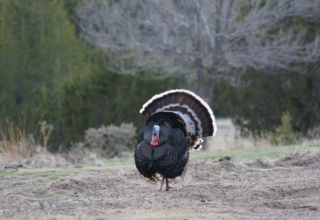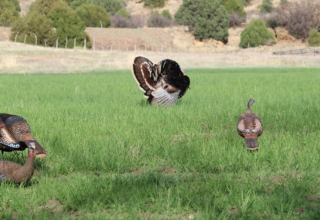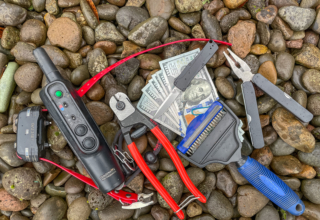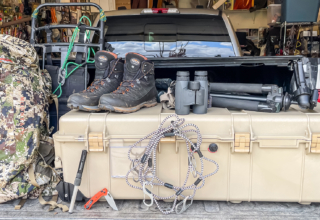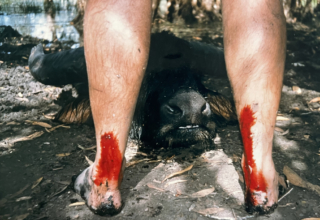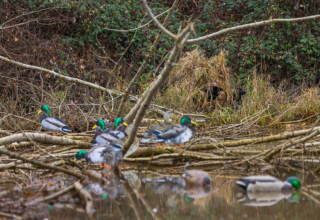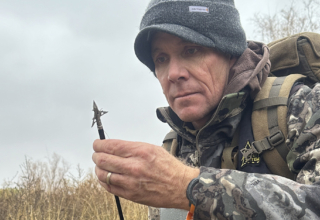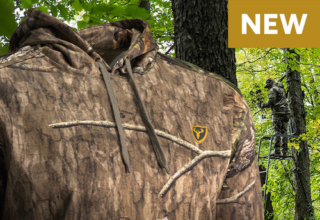Too many turkey hunters wait for turkey season to locate birds; by then, you’re behind the eight ball. Combine time in the woods with reliable trail cameras and good optics and be ready to go come opening day.
by Scott Haugen
By the time April 15 rolls around — the opening day of spring turkey season in my home state of Oregon — I’ve spent more time scouting than I will hunt the entire season. Let’s take last season, for example.
We had unseasonably warm, sunny days beginning in mid-January. While hunting ducks along a river bottom one day, I heard some turkeys gobbling, and I found seven toms strutting, chasing one another, and gobbling like crazy. Their heads were bright red and winter plumage full, making their puffed-up bodies seem huge. The next day, I started setting up trail cameras in the area.
Three months later, by the start of the season, I’d driven over 450 miles scouting for turkeys. I’d spent more than 100 hours walking in the woods, scouting, setting, and checking trail cameras, and devoted dozens more hours to studying trail camera video footage.
On opening day, I took a first-time turkey hunter out, and he shot a tom. I punched my first of three tags the following morning in the foothills of the Cascade Range. By season’s end, I’d filled my three tags and helped a few friends get their birds. In total, I’d spent less than 10 hours hunting spring turkeys, which was a part of seven successful hunts, and all because of pre-season scouting efforts.
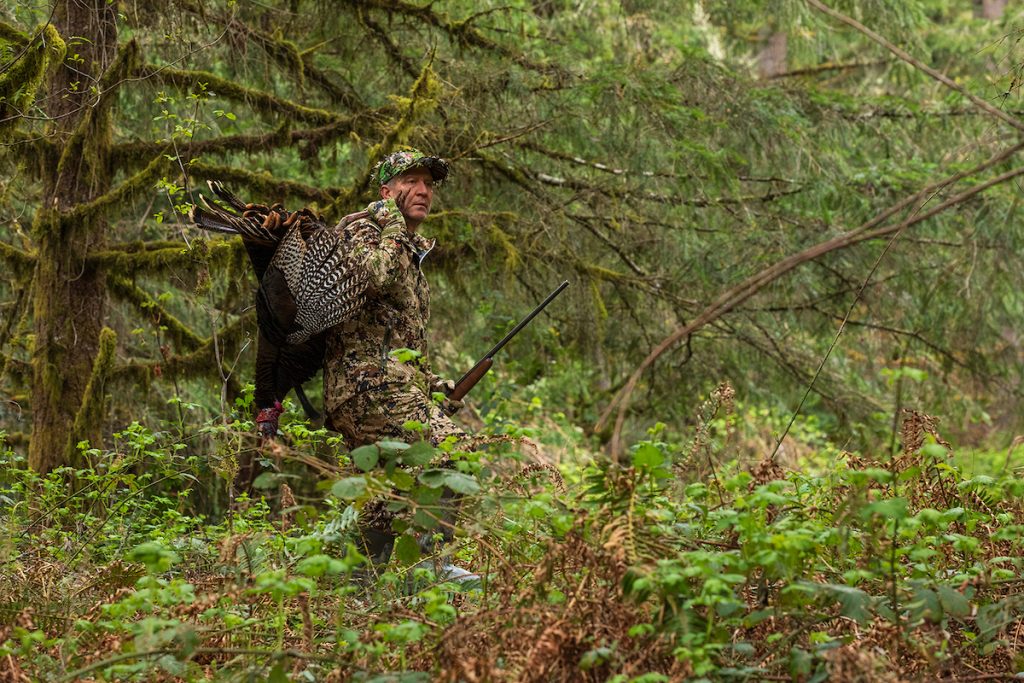
Why spend so much time scouting for turkeys? Because in the hill country where I hunt, turkeys move a lot. In late winter, toms will be in bachelor flocks at lower elevations. As bachelor flocks disperse, toms may travel a few miles, even more, to reach spring strutting grounds.
Some toms I’ve tracked have traveled over 10 miles, climbing over 3,000 feet in elevation. Hens fitted with transmitters have been known to travel over 15 miles from their wintering grounds to their annual breeding and nesting sites, and rest assured, where hens go, toms will follow.
In one section of coniferous hills where I’ve taken several turkeys over the past 25 years, one season might find the three-mile long, one-mile wide ridge holding over a dozen toms, and other springs may only find one or two toms calling and strutting. By turkey season, I want to be hunting rather than scouting for a place to hunt.
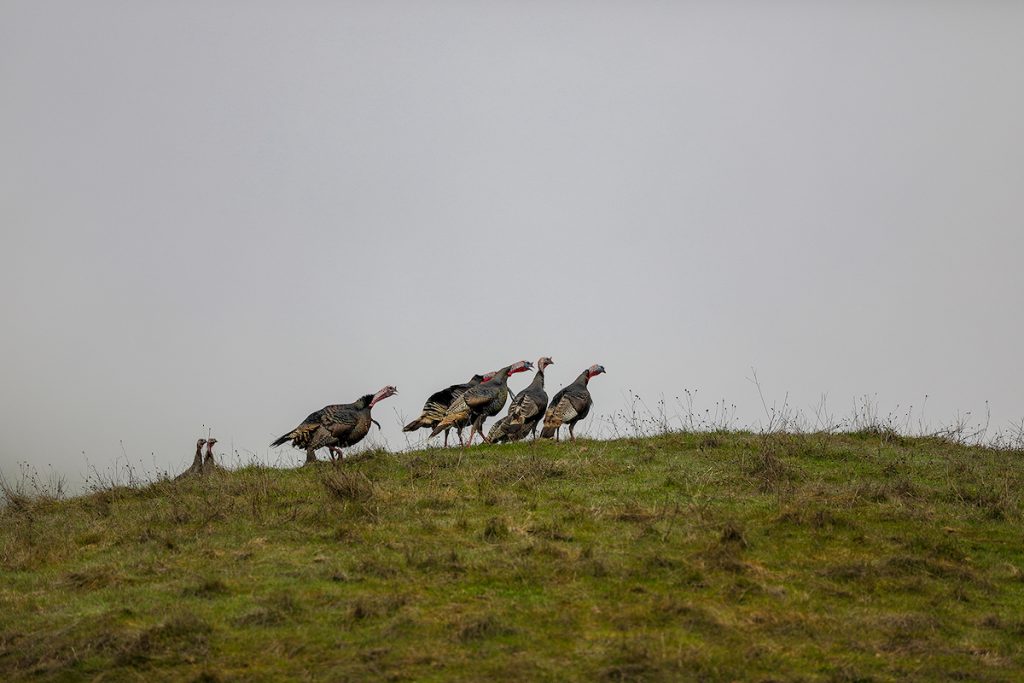
Turkey Behaviors
As a former biology teacher, I approach my hunting from a scientific angle based on animal behavior, habitat changes, and shifts in weather. With turkeys, this means locating birds in large winter flocks and tracking their movements and behavioral changes with each passing day.
Starting in late January, I search for bachelor flocks of toms and those with hens with young of the year and try to keep track of them through February and March. By March, turkey behavior changes rapidly. Toms go from tolerating one another in bachelor flocks all winter to establishing dominance through posturing and fighting to gain breeding rights. Throughout the West, big country influenced by snow, rain, and even high winds and sunshine, can impact turkey behavior, and it’s interesting to watch these changes unfold and, better yet, understand why.
By mid-March, a tom’s mind is consumed with breeding, as testosterone levels are high. Hen’s are also keen to breed, but once they start laying eggs, they turn reclusive. While the urge to reproduce makes spring turkey hunting so unique, remember that turkeys must eat, drink, take dust baths, and roost every night. One of the biggest mistakes I made when hunting years ago was focusing too much of my efforts on the breeding cycle of turkeys, neglecting a turkey’s daily survival needs.

In many western states, turkeys move to higher elevations as spring progresses; hens often move to high ground to nest in seclusion. I’ve witnessed hen movement from the Coast Range into the Rocky Mountains, and toms always seem to follow them.
At the same time, many turkeys are year-round residents in low elevations where food is easy to get and cover, and roosting trees abound. Pre-season scouting reveals if you’re hunting homebody birds or turkeys on the move. Hens should be a primary target when pre-season scouting because toms will find them wherever they go.
The height of turkey breeding is about one month before the start of hunting seasons in most regions of the West. However, peak breeding can see delays due to drastic weather changes. Keeping track of daily tom and hen movement this time of year is essential, as is tracking the behavior shifts among toms from passive to aggressive. Watch the weather, and you’ll see cold fronts and harsh storms can delay courting and breeding, too.
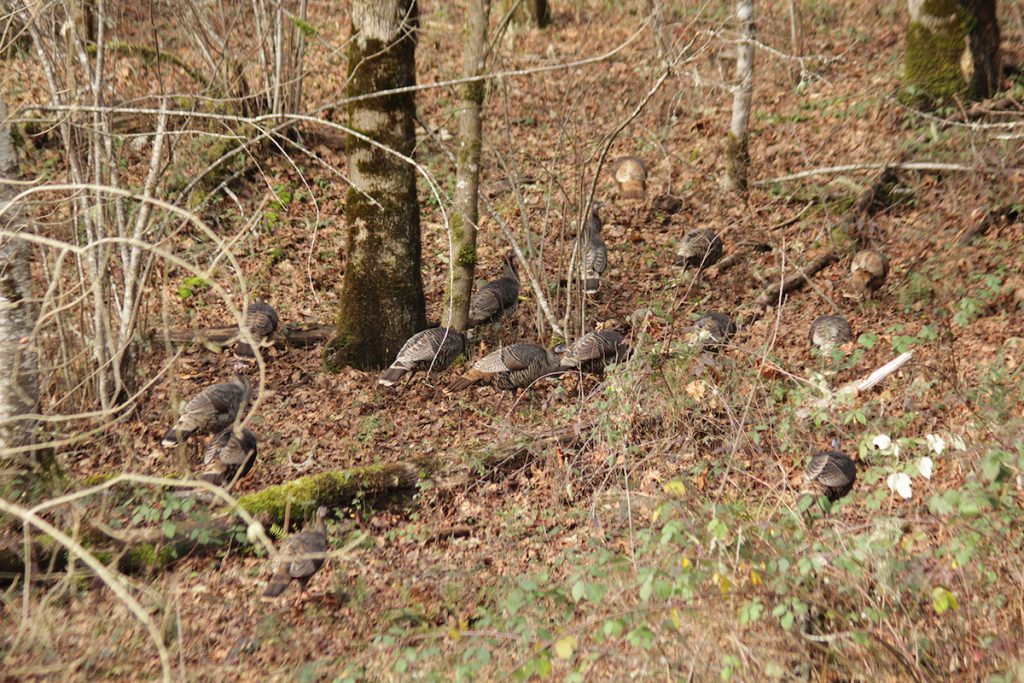
Exactly how a turkey behaves and when behavioral changes occur can vary from year to year, even from drainage to drainage. I used to think shifts in turkey behavior were dictated by photoperiodism, as with big game. Still, after 36 years of hunting turkeys throughout the West, I believe much of a spring turkey’s behavior is influenced by current weather conditions. I’ve seen the height of the breeding season delayed many years when conditions were cold and wet. In other years I’ve seen it well underway in late February.
Turkeys don’t always behave in a specific way, day in and day out, year after year, and I feel the big, rugged land and diversity of habitats throughout the West, along with constantly changing weather patterns, impact this. Exposure to severely cold, late winters, and delayed springs impact turkey movement and behavior, which is why scouting is essential, so you know where birds are physically and how their courtship is progressing.
Understanding Turkey Sign
When scouting, you don’t have to see turkeys to be successful. An excellent place to start is with tracks. A mature tom’s track will measure up to 5 inches from the back toe to the tip of the long middle toe. A hen’s track will be about 4 inches, while jakes fall somewhere between. The size of a turkey’s track changes with age, and the older a tom, the bigger and thicker its feet become, often revealing swollen knuckles on each toe. Loose feathers on the ground also reveal a story. The breast feathers of toms are edged in black, while a hen’s breast feathers are tan or off-white on the fringe.
Tom and hen droppings also differ. The droppings of toms are usually in an elongated J-shape, while a hen’s droppings are typically coiled and contain more white coloration than found in tom poop. In winter, you’ll also see where flocks have scratched for insects under trees and along moist ground sections.
As spring approaches, tom behaviors change. Winter bachelor flocks split up, and old toms often go out independently. By nature, toms visit the same strutting area daily, gobbling and calling to attract hens. Strutting grounds are great places to focus hunting efforts, which can be found during pre-season scouting. When you kill a mature tom from a strutting area, return later in the season, as another tom will have likely taken over the location. This is an excellent tip for those living in states that allow a hunter to have two or more tags and those that love taking other hunters into the turkey woods.
Strutting grounds, roost trees, and pathways connecting the two should be pinpointed while scouting. Locating multiple toms is wise if you need a backup plan or have various tags to fill.
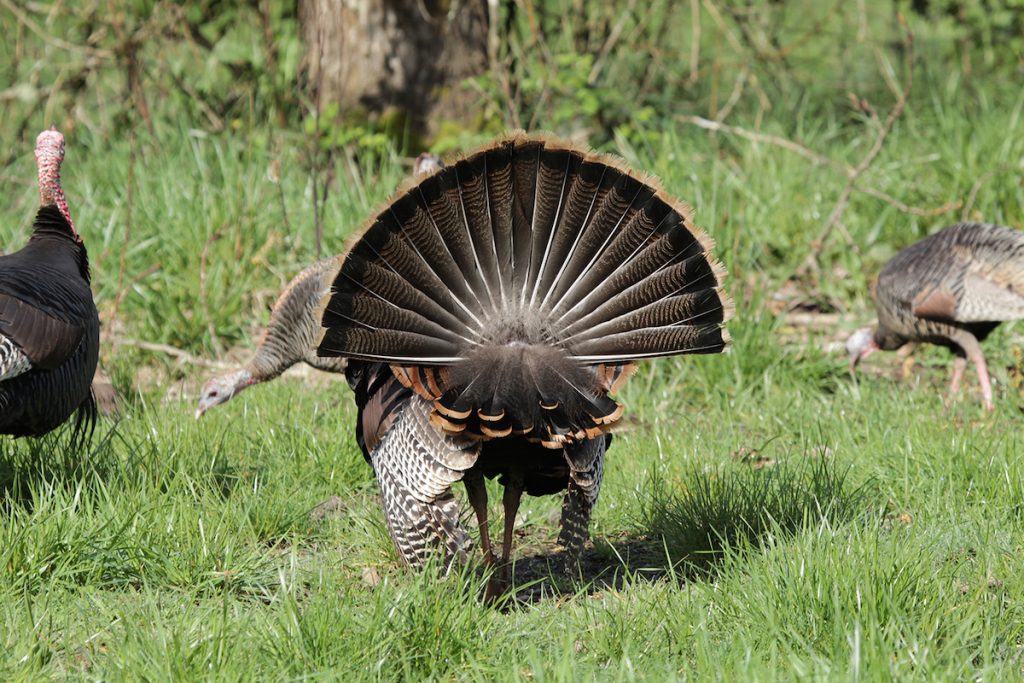
Scouting Missions
Trail cameras are valuable scouting tools and are your eyes in the woods when you’re not there. I use trail cameras year-round for turkeys, always setting them on video mode. Still pictures allow you to count birds and size-up toms, but photos miss a lot of what’s happening in the turkey woods, and I want to see it all.
Capture a photo of a lone hen, and that’s all you see. But get a 10-second video of a hen, and you might hear multiple toms gobbling off-camera or notice birds moving in the background.
My go-to trail cameras are Stealth Cam’s DS4K and Browning’s Dark Ops. Both cameras have outstanding clarity, hold up in various weather conditions, and capture sounds. I’m impressed with their battery life, too. I’m not a fan of running transmitting trail cameras for turkeys because the more time I spend in the woods checking them, the more I see and learn. In other words, trail cameras force me to head out, and that’s where I see things the cameras don’t catch.
I like hanging trail cameras between two and six feet off the ground, depending on how open the trails are, and pointing them directly down as much of the trail as possible. The more of a path you can cover in the shot, the more footage you’ll have of turkeys on the move, feeding, strutting, and gobbling.
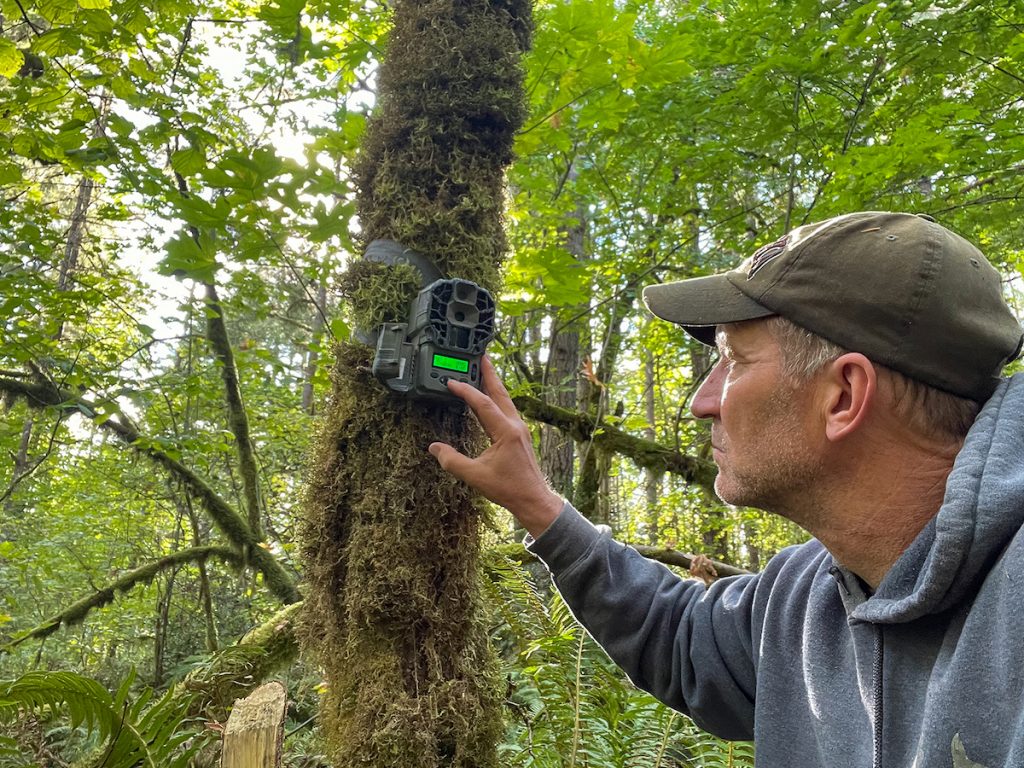
A spotting scope is the second-best tool for scouting for turkeys out West. A spotter, or binoculars, will allow you to locate and study turkeys from afar. Good optics let you cover the ground with your eyes, not your feet, saving time and allowing you to see turkeys without them knowing you’re there. When scouting, the goal is to find turkeys without being seen.
If scouting time is limited in February and March, try to pick sunny and unseasonably warm days. It only takes one day — actually only a few hours — of warm weather to get toms fired up and gobbling. Once these toms are located, start setting trail cameras and monitoring their movements and behaviors.
At the same time, locate flocks of hens and their young, and set trail cameras where their daily patterns lead. Turkeys are habitual in the winter months, covering the same ground, sometimes day after day for weeks, searching for food in the known locations.
Warm weather brings out more insects and gets greenery sprouting, and the turkeys will find these food sources. As turkey flocks disperse, try keeping track of them. By locating multiple toms, you’ll find yourself hunting on opening day, not searching for a place to hunt.


